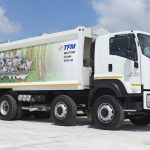Daimler ditches platooning!

Incredibly, after years of hoo-ha surrounding the topic of platooning, the concept has been ditched by the world’s biggest manufacturer of commercial vehicles!
This revelation came from Martin Daum, member of the board of management of Daimler AG with responsibility for Daimler Trucks & Buses, who was addressing the world’s commercial vehicle media at a press conference at the Consumer Electronics Show (CES) in Las Vegas.
Daum told us lots of other interesting stuff (more about that later), but it was the divorce from platooning that really got the journalists’ tongues wagging. We hadn’t seen that one coming!
Daimler’s reasoning behind the decision does, however, make sense: according to Daum, even in perfect platooning conditions, fuel savings are less than expected. Those savings are, of course, further diminished when the platoon gets disconnected and the trucks must accelerate to reconnect.
He made us all laugh when giving a really practical example: “What happens if the one driver needs a bathroom break? Either both drivers must have a bathroom break at exactly the same time, or your fuel savings are gone,” he noted with a chuckle.
The other huge announcement at the press conference was: Daimler will probably be running autonomous trucks on America’s roads by the end of this year. We didn’t see that one coming either!
Associated to this announcement was the news that Daimler Trucks will invest €500 million (R7,62 billion) in a global push to bring highly automated (level-4) trucks to the road within a decade.
The new Freightliner Cascadia, which made its world premiere at the CES, offers level-2 automation. So, it offers partially automated driving features (as we experienced out on the road, the truck can brake, accelerate and steer itself), and it’s also the first-ever partially automated series production truck on North American roads.
One would assume that the next step would be a level-3 truck, but not so, maintains Daimler. “Level-3 automated driving does not offer truck customers a substantial advantage compared to the current situation, as there are no corresponding benefits to compensate for the technology costs,” we were told.
If other truck manufacturers do develop level-3 trucks, these vehicles will be able to make informed decisions for themselves (such as overtaking slower moving vehicles). Human intervention will be needed, however, when the machine is unable to execute the task at hand or the system fails. However, a level-4 truck should be able to intervene, and it doesn’t rely on a human to make things right.
I’m guessing that the other manufacturers will also adopt the level-3 leapfrog approach. After all, as Daum told the media, Daimler has considerable experience when it comes to self-driving trucks. “As a leader of our industry, we’ve been pioneering automated trucking. In 2015, our Freightliner Inspiration Truck got the first road licence ever for an automated commercial vehicle.
“Now we take automated trucking to the next level: we’re ready to launch the first partially automated new Freightliner Cascadia in 2019 – and next, we will tackle highly automated trucks. Highly automated trucks will improve safety, boost the performance of logistics and offer a great value proposition to our customers – and thus contribute considerably to a sustainable future of transportation,” he noted.
Given the fact that global road freight volume is expected to more than double between 2015 and 2050, this can only be a seriously good thing.
Published by
Charleen Clarke
focusmagsa




